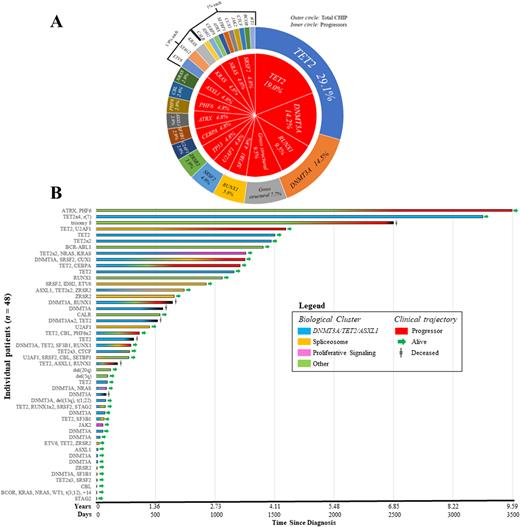Abstract
Background: The International Consensus Classification (ICC) recently recognized clonal hematopoiesis of indeterminate potential (CHIP) as a clinically defined pre-malignant state. A subgroup of patients with clonal hematopoiesis (CH), herein termed progressors, ultimately develop to a frank clinical diagnosis, while others, herein termed non-progressors, may have CH indefinitely with variable risk of progression. Although eight years have passed since the large-scale descriptions of CHIP as an age-related phenomenon, the risk factors for progression and management guidelines are still not well-defined. Moreover, while many quaternary care centers have developed CHIP databases, little is known about the epidemiology of CHIP from tertiary care centers that draw patients from the community setting.
Methods: Patients with CH were identified via concurrent morphologic, cytogenetic, and molecular diagnostics of bone marrow aspirates reviewed by UMass Hematopathology between 2013 and 2022. CH was defined here as per the 2022 ICC: presence of a somatic mutation with variant allele frequency (VAF) ≥ 2% on molecular diagnostics or non-myelodysplastic syndrome (MDS)-defining clonal cytogenetic aberration in a patient without morphologic evidence of myeloid neoplasm. Patients with germline mutations were excluded. Independent review of all bone marrow aspirates was performed by at least two pathologists. This study included a pre-selected group of patients who had an indication for bone marrow evaluation; reasons for performing bone marrow evaluation included presentation with pancytopenia (41.7%), anemia (14.6%), leukocytosis (12.5%), thrombocytopenia (6.3%), leukopenia (4.2%), bicytopenia (4.2%), staging workup for a lymphoma (4.2%), erythrocytosis (4.2%), thrombocytosis (4.2%), abnormal radiographic marrow signal (2.1%), eosinophilia (2.1%). A total of 48 patients with CH were identified.
Results: A total of 102 aberrations were found among 48 patients with CH. The mean, median, mode, and range for CH aberrations were 2.15, 1.5, 1, and 5, respectively. The mean age at detection of CH for non-progressors was 69.2 ± 1.8 years vs. 63.1 ± 3.5 years for progressors (p = 0.072). The most prevalent somatic variants in CH were: TET2 (29.1%), DNMT3A (14.5%), and gross structural abnormalities (7.7%) (Panel A, outer circle). Progressors had a distinct profile (Panel A, inner circle). Zero of 48 patients with CH carried TP53, IDH1, or EZH2 aberrations. The most prevalent genomic disruptions were missense mutations (45.6%), nonsense mutations (15.6%), and frameshift deletions (13.3%). We assessed the clinical trajectory of patients with CH (Panel B). Nine (18.8%) of 48 patients progressed to neoplasm (confirmed by bone marrow evaluation). Median overall survival (OS) at the time of analysis was 6.85 years, with longest follow up of 9.58 years. For non-progressors, median OS was not reached. For progressors, median OS was 6.85 years (from time of identification of CH). Median time from identification of CH to frank neoplasm was 1.05 years. For progressors, median time from diagnosis of frank neoplasm to death was 1.76 years. Of the 14 patients harboring DNMT3A, TET2, or ASXL1 (DTA) mutations alone, without mutations in other biological clusters, none (0%) progressed (Panel B,blue bars).
Conclusion: In contrast to the original reports of CH, which studied unselected patients from multiple consortia, the patients in our study were pre-selected for suspicion of an underlying hematologic condition, reflecting real-world data. CH spans multiple functional clusters that are recurrently mutated in MDS and/or acute myeloid leukemia (AML), with the notable exception of TP53, IDH1, and EZH2. This may be due to more rapid progression to malignancy for those mutations, with only a transient, if any, CH state. All patients who progressed with DTA mutations did so only in the presence of additional mutations - at least a second mutation was required for DTA cases to progress. There was a trend toward significance for younger mean age at CH detection for progressors vs. non-progressors. Lead-time bias may skew OS results for patients found to have CH at an early point; and CH detected at a younger age may be more likely progress, leading to shorter OS. Systematic studies are needed to more comprehensively profile CH and develop formalized risk-adapted management strategies.
Disclosures
Patel:Bristol Myers Squibb: Consultancy, Honoraria, Membership on an entity's Board of Directors or advisory committees; Pfizer: Consultancy, Honoraria, Membership on an entity's Board of Directors or advisory committees. Cerny:Jazz Pharmazeuticals: Consultancy, Honoraria, Membership on an entity's Board of Directors or advisory committees; Pfizer: Consultancy, Honoraria, Membership on an entity's Board of Directors or advisory committees; Amgen: Consultancy, Honoraria, Membership on an entity's Board of Directors or advisory committees; Actinium Pharmaceuticals: Current equity holder in private company; Bluebird Bio/2Seventy: Current equity holder in private company; Dynavax Technologies: Current equity holder in private company; aTyr Pharma: Current equity holder in private company; Gamida Cell: Current equity holder in private company; Miragen Therapeutics: Current equity holder in private company; Mustang Bio: Current equity holder in private company; Novavax: Current equity holder in private company; Ovid Therapeutics: Current equity holder in private company; Sorrento Therapeutics: Current equity holder in private company; TG Therapeutics: Current equity holder in private company; Vaxart: Current equity holder in private company; Veru: Current equity holder in private company. Ramanathan:sanofi: Current holder of stock options in a privately-held company; novartis: Current holder of stock options in a privately-held company; J and J: Current holder of stock options in a privately-held company; moderna: Current holder of stock options in a privately-held company; vertex pharma: Current holder of stock options in a privately-held company; pfizer: Current holder of stock options in a privately-held company; gilead: Current holder of stock options in a privately-held company. Abel:Novartis: Consultancy. Gerber:US Patent and Trademark Office: Patents & Royalties: US Patent No. 11,209,435; US Patent and Trademark Office: Patents & Royalties: US Patent No. 10,222,376; US Patent and Trademark Office: Patents & Royalties: US Patent No. 9,012,215; Novartis Pharmaceuticals Corporation: Consultancy, Honoraria, Membership on an entity's Board of Directors or advisory committees.
Author notes
Asterisk with author names denotes non-ASH members.


